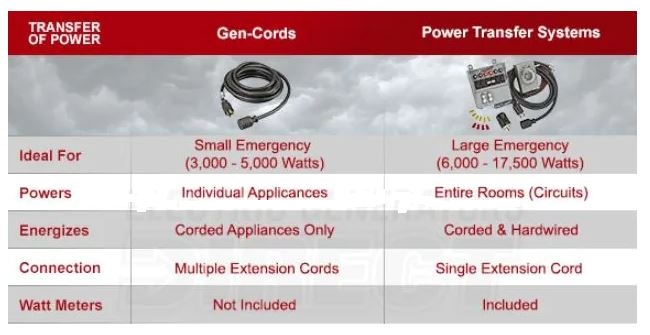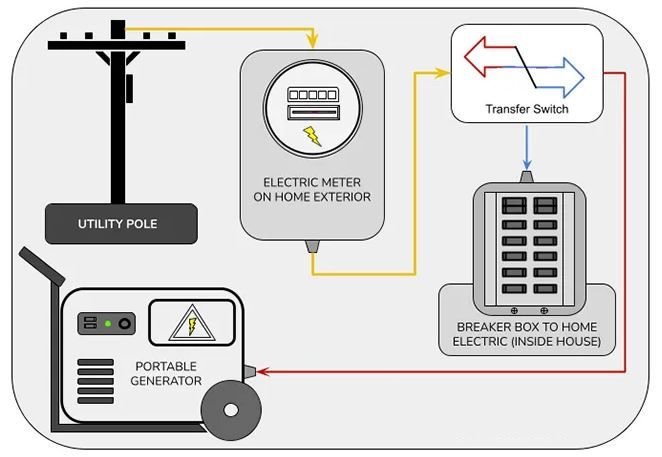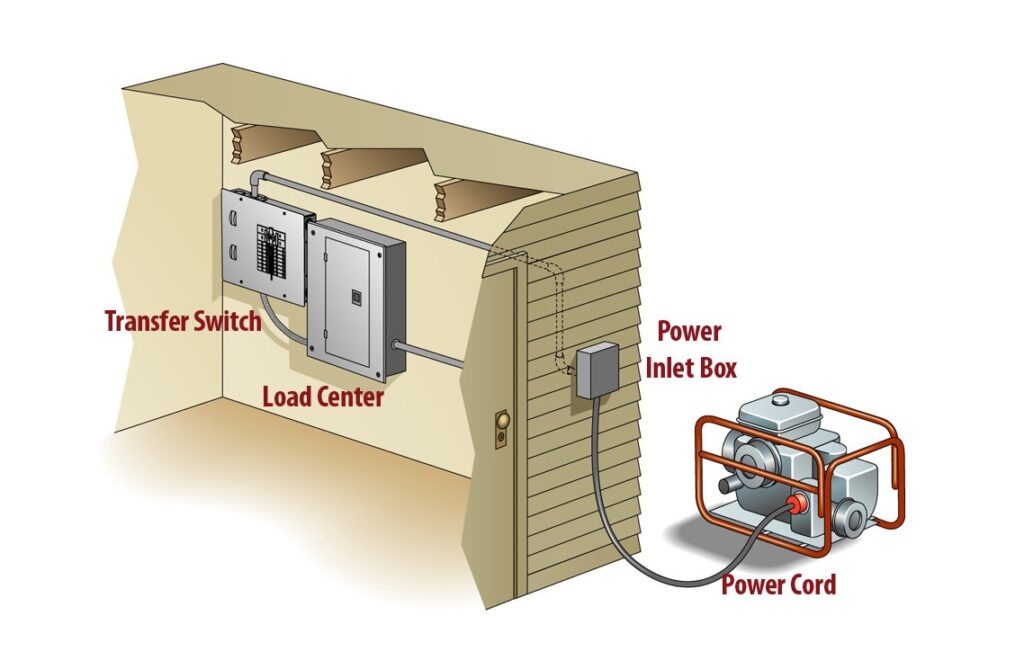How to Connect a Generator to Your Home? When the primary power source, particularly the one from the national grid, fails, a portable generator can supply emergency electrical power to a residence. Only the most necessary services, such as lighting, a TV, a refrigerator, etc. must be powered by it. All other equipment in the house should not be considered. Many appliances, including stoves, air conditioners, and tumble dryers, consume too much energy to be powered by a normal portable generator.
How to Connect a Portable Generator to a Home?
An excellent first step in defending your family from a power outage is to purchase an emergency generator. However, not even the most ardent prepper can foresee the next power outage. Manufacturers, distributors, suppliers, and companies all provide a variety of generators, and Linquip offers a big assortment of Generators for Sale.
Linquip’s website has a comprehensive list of generator services for all OEM fleets. Vendors from Linquip can help you with this. To learn more about how to connect with a varied collection of Service Providers who consistently produce high-quality products, please contact Portable Generators Experts.
There are two ways to connect a portable gas generator to a house: either by connecting each appliance to a separate cord or by utilizing a transfer switch to power a circuit panel.
Cords vs Power Transfer Systems
The most common query you receive during hurricane season is, “What’s the difference between extension cords, generator cords, and utilizing a switch?” The solution is fairly easy. It ultimately boils down to comfort and security. Let’s examine both categories and their applications.

Connecting a Portable Generator to a House
No matter what kind of generator you have, you should always read the owner’s handbook for specific instructions and safety precautions before using it. Backfeeding, or connecting a generator to a wall outlet, is never recommended. If you decide to use a transfer switch, have it professionally installed?
Extension and Gen-Cords
Follow the pre-start checklist for the generator.
Outdoors, move the generator (min. 10ft away from openings).
One of the following approaches can be used to connect the generator to interior appliances:
- From the generator, connect a single-gen cable to several appliances.
- To connect to appliances, run many extension wires from the outside.
- Fire up the generator.
Transfer Switches
- Using a gen cable, join the generator to the transfer switch.
- Outside, turn on the generator.
- Change the transfer switch’s primary breakers from “Line” to “Generator” power.
- The circuits you want to power should be turned on one at a time.
How Should I Connect My Generator?
Extension Cords
Of course, utilizing extension cords is the cheapest option to connect a generator. But they won’t let you utilize a big generator to its full capacity. It’s like buying something and then only getting to utilize half of it.
What is less clear is that using extension cables may be time-consuming and dangerous, particularly during a blackout or a severe storm. In reality, utilizing a wire that is the incorrect gauge, the improper length, or that is worn out puts users at risk for shock and fire. A suitable extension cord will work if you’re using an inverter and simply need to power a few items, such as a refrigerator and some lights.
Generator Cords
Your best option is to spend money on a Gen-Cord if you’re using a mid-sized generator and feel secure plugging in appliances during a storm but still want to utilize cables.
Simply connect the gen cable to the generator’s 20- or 30-amp outlet. The other end divides into several domestic outlets, where you may begin safely securing extra extension cables indoors.
Power Transfer Systems
Power transfer systems are the greatest choice for connecting a big portable generator in terms of power, safety, and convenience. They are equipped with everything you require to connect your generator to your home.
More significantly, power transfer techniques activate complete circuits as opposed to individual appliances. Hardwired equipment like air conditioners, heaters, security systems, and lighting can be powered by them.
Using a Transfer Switch to Connect a Generator to House
An electrical control device called a transfer switch is something you put next to your house’s circuit breaker box. The transfer switch’s primary function is to move the electrical grid of your home from the utility electrical grid to your generator.

A transfer switch can also be used to simplify power management. Similar to the circuit breaker in your house, the transfer switch enables you to load various rooms, outlets, or appliances on several sub-breakers. When you install the transfer switch, you have control over which outlets are on which sub-breaker.
Simply turning one breaker on and off will change how much power is being consumed by your generator. In this manner, you can have your entire house hooked into the generator and merely utilize it to run specific appliances. In the end, you may utilize a smaller portable generator to power your house thanks to this.
Manual vs. Universal Transfer Switches
Transfer switches are typically offered in two different configurations: manual and universal.
A typical breaker box functions similarly to a manual transfer switch. You just need to flick the correct breaker to turn on or off a certain group of appliances.
This procedure is automated using universal transfer switches. The transfer switch will automatically turn breakers on and off to keep the total power consumption below your generator’s maximum rated load once you choose which outlets and appliances have precedence.
The ability of universal transfer switches to automatically identify when the utility grid loses power and switch to the generator makes them useful as well. Even some switches come with a battery backup to enable you to power appliances until you can start your generator. Similar to universal switches, when the electricity is restored, your home will be instantly reconnected to the electrical grid.
Installing a Transfer Switch
Since changing the cables that enter your home’s circuit breaker board is required for the installation of a transfer switch, a qualified electrician should be consulted. However, installation may also be carried out by homeowners who have some electrical wiring knowledge, and the majority of transfer switches come with detailed installation manuals.
Choosing which circuits from your main circuit board will be transferred to the transfer switch’s circuits is the most crucial stage in the installation of a transfer switch. The size of your generator and the appliances you intend to use during a power outage will determine this. The priority levels of various appliances must be programmed into a universal transfer switch.
Connecting Your Generator to Your Home
To connect the generator to the transfer switch, a specific generator cord is required. This cord connects to the inlet on your transfer switch and the outlet on your generator (like this).
It is feasible to leave your generator connected to the transfer switch continuously to be ready for an outage in advance. Otherwise, it’s a good idea to keep the generator cable close to your generator or transfer switch because you’ll be wandering around in the dark during a power outage.
Flip the main breaker on the transfer switch so that it is getting power from the generator intake rather than from the utility electrical grid before turning up your generator. If you are utilizing a manual transfer switch, ensure that all of the breakers are shut off at this time as well.
Ensure that your generator is outside or in a place with good ventilation before turning it on. To power up your house, you may now flip on the breakers on your transfer switch one at a time.
Simply perform the other direction when the outage is over. To ensure that a manual transfer switch is ready to use when the next power loss occurs, don’t forget to shut off all of the breakers.
How To Hook Up a Generator to Your House Without a Transfer Switch
To begin with, installing a Transfer Switch is unquestionably the best way to connect your home to your generator. A transfer switch helps guard against harm to your generator, electronics, and wiring. They can also put out flames. If you want to travel this route, use caution and abide by local rules and regulations. It is advisable to get assistance from a certified electrician!
Step 1: Invest in an interlock kit to turn off the main power correctly before turning on the generator power.
- Without a transfer switch, a generator can be connected with the aid of an interlock kit. In essence, it prevents the main breaker from being closed before the generator powers the box. The generator won’t ever accidentally back feed into your utility line thanks to this.
- Make sure it is the right size and model for your service box. Purchase the EXACT match, if possible.
Step 2: To allow power from your generator to enter your box, purchase a circuit breaker.
- It is important to consider how much electricity your generator will produce when you purchase the breaker. A suitable amperage 220/240-volt breaker can usually be found for your generator.
Step 3: Purchase the necessary cables, plugs, and tools.
Purchasing a 240-volt extension cable with the appropriate amperage for your generator makes sense depending on your situation.
Choose a location for the exterior receptacle of your generator after that. Purchase a suitable outside generator plug that is waterproof, then put it on the outside of your house.
Make sure you have a decent pair of work gloves and safety glasses in addition to the standard electrical gear (screwdrivers, pliers, wrenches, electrical tape, drill, etc.). Electricity and wiring work is no joke!
Step 4: Connect to the power box after installing the outside generator plug.
Choose a location for the exterior receptacle of your generator after that. Purchase the proper wire and outdoor generator plug to connect to your power box. Have an electrician use the circuit breaker to connect your outside plug to your power box.
Step 5: Install the Interlock Kit
- Install the interlock kit on your panel, then finish. Once more, doing so will stop your generator from being connected at the same time as your main electricity.
Check out the video instruction for a thorough explanation of how to connect a generator to your home.
Buy Equipment or Ask for a Service
By using Linquip RFQ Service, you can expect to receive quotations from various suppliers across multiple industries and regions.
Click Here to Request a Quotation From Suppliers and Service Providers
Read More In Linquip
- Parts of DC Generator: Explanation of Parts, Working, Types, Advantages & Disadvantages
- What Is a Generator? A Comprehensive Explanation of Working Principles, Types, and Components
- What is the Right Size Generator for a 50 Amp RV? A Complete Guide
- What is the Working Principle of a DC Generator?
- Types of Generators: Learn the Basics, Get the Most Out f it!
- Best Portable Generators: Everything You Need to Know
- Generator Maintenance: The Most Essential Tips to Know
- The Biogas Generator: A New Approach to the Future of Fuels and Energy
- Difference between single-phase and three-phase generators: An ultimate guide
- 3-phase generator: a brief review of everything you need to know
- Induction Generator vs Synchronous Generator: A Comprehensive Comparison
- A Clear Classification of DC Generators
- What are the parts of AC Generators?
- What are The Electric Generator Parts?
- What is Generator Efficiency? Calculation & Formula Guide
- How Long to Wait After Using Ozone Generator? Best Guide
- How to Use Ozone Generator in the Home? Best Solution
- More Details about Siemens Generators
- More Information about Siemens Generators Services
- Read More Information about Siemens Generator Installation Services
- Read More Details about Siemens Generator Maintenance Services
- More Information about General Electric (GE) Generators
- More Information about GE Generator Services
- More Details about GE Generator Installation Services
- More Details about GE Generator Maintenance Service
- What are Alstom Generators? (Clear Guide)



